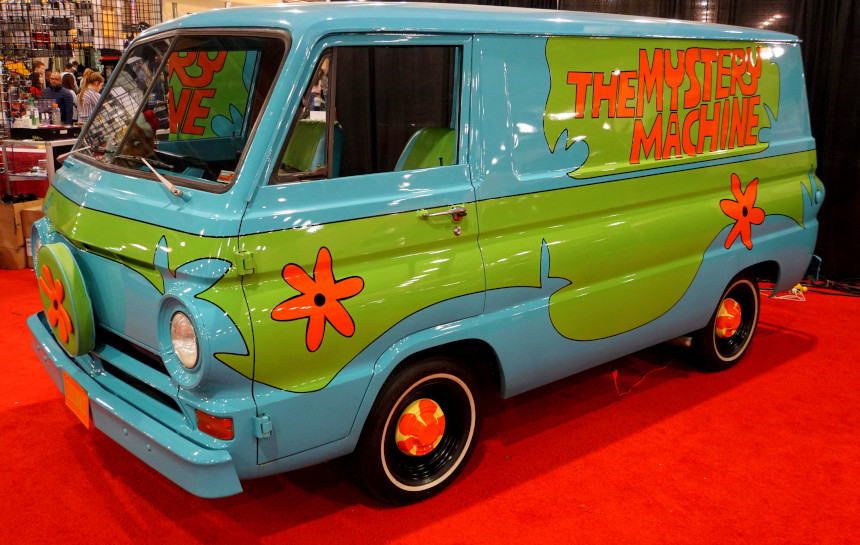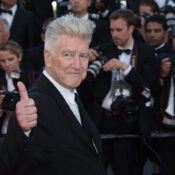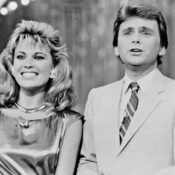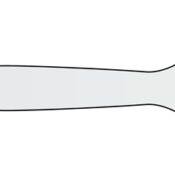Think for a moment about the greatest mystery solvers in the history of television. Who belongs on that list? Columbo, certainly. The variation incarnations of Sherlock Holmes. Probably Magnum or Jessica Fletcher and Jim Rockford, along with Luther and Monk and Mannix. Kojak and Veronica Mars, Pembleton and Bayliss, Jimmy McNulty? The list is seemingly endless, but it would certainly be incomplete without the team of Mystery, Inc. Over the course of 14 distinct series and dozens of movies, four friends and their canine companion have captured criminals disguised as all manners of spooks and specters while occasionally running afoul of true supernatural threats and super-villains. Believe or not, Fred, Daphne, Velma, Shaggy, and Scooby-Doo turn 50 this September. Here’s a look at their mystery history, from 1969 to their brand-new streaming series.
1. Scooby-Doo, Where Are You? (1969-1972, CBS)
The original Hanna-Barbera series introduces us to the four teens of Mystery, Inc. (Fred Jones, Daphne Blake, Velma Dinkley, and Norville “Shaggy” Rogers) and Shaggy’s best buddy, Great Dane Scooby-Doo. From the beginning, Scooby talks, but frequently starts words with a “R,” which leads to such famous pronunciations as “Ruh-Roh” and “Raggy” (when yelling for his best friend). Most of the recognizable conventions of the series are evident in the earliest episodes, which generally involve criminals trying to cover their tracks by pretending to be supernatural creatures; the “meddling kids” invariably solve the mystery through a combination of Velma’s research, the group’s combined clue-finding, Fred’s elaborate traps, and Shaggy and Scooby’s fear-driven haplessness. Also present from the start is their groovy van, the Mystery Machine. Twenty-five half-hour episodes were produced, and they ran over and over. From the first episode to the present day, the voice of Fred has been acted by Frank Welker.
2. The New Scooby-Doo Movies (1972-1974, CBS)
Among the most fondly remembered episodes by fans are the 24 New Scooby-Doo Movies installments. Clocking in at an hour each, every show featured a different celebrity guest-star, both fictional and from the real world. The gang was just as likely to solve a mystery alongside Mama Cass Elliott and Don Knotts as they were to team up with Batman and Robin or Josie and the Pussycats; when real-life celebrities appeared, they also provided their own voices. Batman and Robin were voiced by Olan Soule and Casey Kasem (who also voiced Shaggy); the dynamic duo of voice actors would also speak for their characters when Hanna-Barbera launched the Super-Friends series in 1973.
3. The Scooby-Doo/Dynomutt Show (1976-1977, ABC)
The gang made the transition to ABC in 1976 after a year reruns on CBS. ABC created new half-hour episodes paired with the new Dynomutt series, which featured the adventures of super-hero Blue Falcon and his dimwitted robot dog, Dynomutt. In November of that year, the network added reruns of Where Are You? to create a 90-minute show-block.
4. Scooby’s All-Star Laff-a-Lympics (1977-1978, ABC)
This is how you can tell Scooby-Doo had become the cornerstone of ABC’s animated line-up. This two-hour, five-show block include three separate Scooby series, plus 11-minute episodes of The Blue Falcon & Dynomutt and new show Captain Caveman and the Teen Angels. The Scooby shows were The Scooby-Doo Show (new episodes), Where Are You? reruns, and an all-new series, Laff-a-Lympics. That show boasted a roster of 45 Hanna-Barbera characters split among three teams competing in Olympic-style events around the world; Scooby led the Scooby Doobies against Yogi Bear’s Yogi Yahooeys and Mumbly’s Really Rottens.
5. Scooby’s All-Stars (1978-1979, ABC)
ABC tinkered with the format in the next year, eliminating the Where Are You? reruns and moving Dynomutt into its own show. All-Stars retained new Scooby episodes, Laff-a-Lympics, and Captain Caveman. In later syndication, the initial run of new ABC Scooby shows was separated out into a package called, appropriately, The Scooby Show, while Laff-a-Lympics, Dynomutt, and Captain Caveman all ran separately.
6. Scooby-Doo and Scrappy-Doo (1979-1980, ABC)
Here begins the most contentious chapter in the history of our mystery-solving dog. Despite the fact that ABC had built a fair chuck of animated programming around the Scooby brand, ratings had begun to decline a bit. The network decided to apply the same logic that they frequently do to long-running sitcoms, and that’s to add a younger character. The “Cousin Oliver” in this particular case was Scooby’s diminutive nephew Scrappy, a smaller Great Dane that was as foolishly brave as Scooby was comically cowardly. The little loudmouth was a hit with younger viewers but disdained by the older audience. Regardless, ratings went up, leading to more controversial moves in the next iteration.
7. The Richie Rich/Scooby-Doo Show (1980-1982, ABC)
Hanna-Barbera took a different approach for the next two seasons. Longtime Harvey Comics character Richie Rich and his supporting cast made their animated debut in this one-hour series, which split alternating seven-minute segments between Richie’s cartoons and the Scooby gang. Not only did ABC’s top dog get second billing, but Fred, Daphne, and Velma were written out of the show, leaving only Shaggy, Scooby, and the divisive Scrappy. Interestingly, the Scooby villains started to drift into actual supernatural territory versus the traditional “crooks in costumes” concept.
8. The Scooby & Scrappy-Doo/Puppy Hour (1982-1983, ABC)
Okay, this is weird. We have the truncated Scooby gang again sharing a show, but this time with The Puppy’s New Adventures, a Ruby-Spears series that spun-out of four ABC Weekend Specials, based on the work of children’s author Jane Thayer, that ran between 1979 and 1981; in the series, Petey Puppy and his dog friends travel to world trying to find his owner, Timmy. This configuration would only last for one season as ABC put the Puppy cast in a new show, The Puppy’s Further Adventures, and put the gang into their own solo show again.
9. The All-New Scooby and Scrappy-Doo Show (1983-1984, ABC)
Hey, look! Daphne’s back! The first 11 episodes of this half-hour series each told two stories; the final two episodes switched back to the full-episode story format. This led immediately into . . .
10. The New Scooby-Doo Mysteries (1984-1985, ABC)
This season followed a similar format to the previous season, alternating episodes that contained single mysteries with two shorter stories. Fred and Velma appeared again in various episodes. One notable episode, “A Halloween Hassle at Dracula’s Castle,” featured a reversal where the gang helps classic monsters like the Count and Frankenstein’s monster figure out who’s been haunting them.
11. The 13 Ghosts of Scooby-Doo (1985-1986, ABC)
13 Ghosts marked a major departure for the series. For the first time, there was an overarching story to the season and a loose continuity between episodes. In the premiere, Scooby-Doo and Shaggy accidentally opened a chest of 13 demons that scattered across the planet. Scooby, Shaggy, Scrappy, Daphne, and their new ally, a child named Flim-Flam, sought to return the demons to the chest with the guidance of Doctor Strange-like mentor Vincent Van Ghoul (voiced by horror film legend Vincent Price). The show ran for 13 episodes, but the plot wasn’t resolved in the final episode. With the drastic change of the next series, the whole conceit was dropped, and would not be revisited until the 2019 direct-to-DVD film Scooby-Doo! and the Curse of the 13th Ghost. During the 1985-1986 television season, ABC also ran a show called Scooby’s Mystery Funhouse; however, this series was composed entirely of reruns from the various 1980 to 1985 shows, and doesn’t count as a true separate series.
12. A Pup Named Scooby-Doo (1988-1991, ABC)
The final Scooby series to run on ABC was a reinvention that de-aged the cast back to junior high kids, while Scooby became the titular puppy. Gone was Scrappy-Doo, and in was a meta sensibility that included bits like breaking the fourth wall and Fred wanting to blame every mystery on a kid named Red Herring. The new iteration proved to be popular and ran for four seasons.
13. What’s New Scooby-Doo? (2002-2006, Kids’ WB)
The Scooby franchise was dormant for a few years save for the Scooby-Doo! In Arabian Knights special on TBS in 1994. In the late ‘90s, Warner Brother embarked on a series of direct-to-video movies starring an updated, more modern version of the gang; these films, which kicked off with Scooby-Doo on Zombie Island in 1998, started off with supernatural adversaries for the first few installments. The videos proved popular enough that Kids’ WB launched a new regular series called What’s New Scooby-Doo? Using the more modern designs and settings, and a modern theme song by the pop-punk band Simple Plan, but the reliable formula of “crooks in costumes,” the show proved extremely popular and ran for three seasons. Mindy Cohn, perhaps best known as Natalie from The Facts of Life, began her run as the voice of Velma, even earning a Daytime Emmy for her work. Grey Griffin, who began playing Daphne with 2001’s direct-to-video Scooby-Doo and the Cyber Chase, continued into this series and has held the role since. Particularly notable was 2003’s A Scooby-Doo Halloween, which featured an appearance (and voice-acting) by legendary rockers KISS, who also performed “Shout It Out Loud.”
14. Shaggy and Scooby-Doo Get a Clue! (2006-2008, Kids’ WB on CW)
A mystifying reinvention of the show, this series focused on Shaggy and Scooby moving into a mansion that was left to Shaggy by an eccentric inventor uncle. A rogue’s gallery attempts to steal a secret invention with Shaggy and Scooby (and occasionally, other members of the gang) work to foil them. It ran for two seasons.
15. Scooby-Doo: Mystery Incorporated (2010-2013, Cartoon Network)
Scooby-Doo’s showdown with the Fright Hound invokes The Terminator and Aliens. (Uploaded to YouTube by Boomerang UK)
A thoroughly modern makeover in all the best ways, Mystery Inc., as it’s known, emphasized tight continuity and an ongoing story that pulled in elements from the entire existence of the franchise. The 52-episode series told one large tale while delving into tangled romantic plots, satire, meta-humor, world mythology, and occasional social commentary (like teacher pay and shallow advertising). Individual episodes were loaded with homages and references, invoking everything from the works of H.P. Lovecraft to James Cameron’s films to Twin Peaks. Other Hanna-Barbera characters appeared, notably the Blue Falcon, Dynomutt, and the cast of Jonny Quest. Writer Harlan Ellison guested twice as himself. After 41 years, Casey Kasem turned the voice of Shaggy over to Matthew Lillard, who had played the character in two live-action films; Kasem stuck around for cameos as Shaggy’s dad. Many other well-known actors voiced regular characters, including Lewis Black, Vivica A. Fox, Gary Cole, Linda Cardellini (who also played Velma in live-action), Patrick Warburton, and Warhol-film veteran Udo Kier, who handled the role of the evil parrot Professor Pericles. Easily the most ambitious version of the show, it remains a high-water mark for Cartoon Network’s non-Adult-Swim work in this decade.
16. Be Cool, Scooby-Doo! (2014-2018, Cartoon Network)
This series reverse-engineered the darker tone of Mystery Inc. and leaned into a more comedic and self-referential vibe. Comedian Kate Micucci signed on as Velma in this run, wherein the animation veered into a more comedy-oriented style reminiscent of other Cartoon Network projects like Regular Show. The durable format also lasted 52 episodes.
17. Scooby-Doo and Guess Who? (2019-?, Boomerang app & streaming)
The trailer for Scooby-Doo and Guess Who? (Uploaded to YouTube by Boomerang Official)
Everything old is new again! Premiering last month on the Boomerang app and streaming service, Scooby-Doo and Guess Who? is a modern update of The New Scooby Movies, with fictional and celebrity guest-stars. The animation has moved back to the style of What’s New and the direct-to-video films. Guests for the new run include Wonder Woman, Sherlock Holmes, Ricky Gervais, Wanda Sykes, Bill Nye the Science Guy, and, of course, the gang’s old pal, Batman.
18. An Aside for the Movies
The first Scooby-Doo television special to run in prime-time was Scooby-Doo Goes Hollywood in 1979; four others have run between 1998 and 2015. Between 1987 and 1994, the gang was featured in four animated TV-movies (Scooby-Doo Meets the Boo Brothers, Scooby-Doo and the Ghoul School, Scooby-Doo and the Reluctant Werewolf, and the aforementioned Arabian Knights). Since 1998, there have been 32 direct-to-video Scooby-Doo films and six shorter direct-to-video specials. Two big-budget live-action films were made in 2002 and 2004; Scooby-Doo and Scooby-Doo 2: Monsters Unlimited were written by James Gunn (known today for directing the Guardians of the Galaxy films) and starred Freddie Prinze Jr., Sarah Michelle Gellar, Lillard, and Cardellini, with the voice of Scooby-Doo provided by Neil Fanning. Two additional live-action TV movies and the direct-to-video Daphne & Velma have appeared. Scooby-Doo and friends are scheduled to return to the big-screen in the 3D-animated Scoob!, which is set for 2020; it’s slated to be directed by Tony Cervone, who is a veteran director and producer of a number of the direct-to-video films.
Over the past 50 years, Scooby, Shaggy, Fred, Daphne, Velma, and even Scrappy, have entered the popular lexicon. Phrases like “Jinkies!” and “Ruh-roh!” are unmistakable in their origins, and an endless number of films and TV shows use the program as a reference point. In addition to TV and video, the gang lives on in web specials, video games, Lego sets, toys, clothing, and more. They say you can’t teach an old dog new tricks; as long as criminals pretend to be ghosts and teenage detectives are willing to meddle, Scooby-Doo doesn’t need to change a thing.
Featured Image: Khairil Azhar Junos / Shutterstock.com
Become a Saturday Evening Post member and enjoy unlimited access. Subscribe now




Comments
Interesante
Actually it’s Daphne Blake not Black